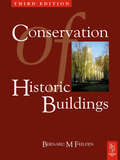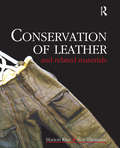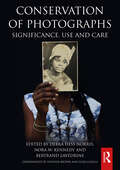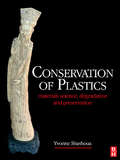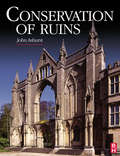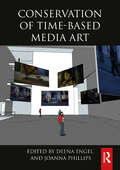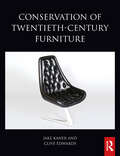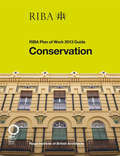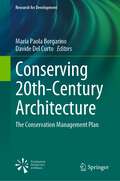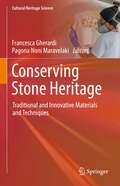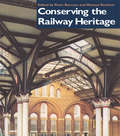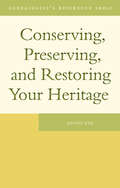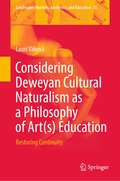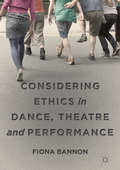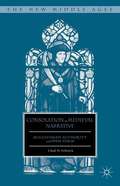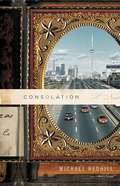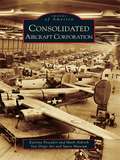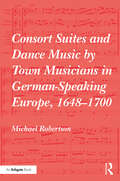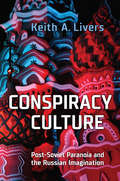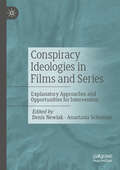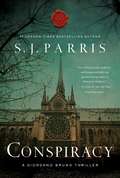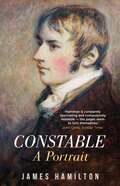- Table View
- List View
Conservation of Historic Buildings
by Bernard FeildenSince its publication in 1982 Sir Bernard Feilden's Conservation of Historic Buildings has become the standard text for architects and others involved in the conservation of historic structures. Leading practitioners around the world have praised the book as being the most significant single volume on the subject to be published. This third edition revises and updates a classic book, including completely new sections on conservation of Modern Movement buildings and non-destructive investigation. The result of the lifetime's experience of one of the world's leading architectural conservators, the book comprehensively surveys the fundamental principles of conservation in their application to historic buildings, and provides the basic information needed by architects, engineers and surveyors for the solution of problems of architectural conservation in almost every climatic region of the world. This edition is organized into three complementary parts: in the first the structure of buildings is dealt with in detail; the second focuses attention on the causes of decay and the materials they affect; and the third considers the practical role of the architect involved in conservation and rehabilitation. As well as being essential reading for architects and others concerned with conservation, many lay people with various kinds of responsibility for historic buildings will find this clearly written, jargon-free work a fruitful source of guidance and information.
Conservation of Leather and Related Materials
by Marion Kite Roy ThomsonThe conservation of skin, leather and related materials is an area that, until now, has had little representation by the written word in book form. Marion Kite and Roy Thomson, of the Leather Conservation Centre, have prepared a text which is both authoritative and comprehensive, including contributions from the leading specialists in their fields, such as Betty Haines, Mary Lou Florian, Ester Cameron and Jim Spriggs.The book covers all aspects of Skin and Leather preservation, from Cuir Bouillie to Bookbindings. There is significant discussion of the technical and chemical elements necessary in conservation, meaning that professional conservators will find the book a vital part of their collection. As part of the Butterworth-Heinemann Black series, the book carries the stamp of approval of the leading figures in the world of Conservation and Museology, and as such it is the only publication available on the topic carrying this immediate mark of authority.
Conservation of Photographs: Significance, Use and Care (Routledge Series in Conservation and Museology)
by Heather Brown Luisa CasellaConservation of Photographs: Significance, Use and Care provides a comprehensive and inclusive overview of theory, research, and practice in the conservation of photograph collections, from the analogue to the digital era.Including insights from nearly 100 leading international professionals, this book is a tribute to the synergistic advancements in photograph conservation in recent decades. Connecting material, imaging, computational and natural sciences, aesthetics, ethics and philosophy, history, art history, art and cultural context studies, these engaging writings contextualize our photographic heritage and its long-term preservation – past, present, and future. This book explores the philosophical underpinnings and evolution of the field, before moving on to detail innovative methodologies for assessing photographic heritage. The inclusion of material on characterization, imaging and authentication studies, conservation practice, innovation and ethical constraints, as well as on current approaches to effective collections management and preventive care, ensures that this volume is an invaluable resource and important practical reference.Conservation of Photographs: Significance, Use and Care will spark a collective drive towards a more complete understanding and preservation of the world’s photographic legacy. As such, the volume is useful for scholars, students, and practitioners working in the fields of photography, conservation, art, art history, history, and cultural heritage.
Conservation of Plastics
by Yvonne ShashouaPlastic objects are included more than ever in museums and galleries collections these days, but these items can start to deteriorate when they a just a few years old. In this book Yvonne Shashoua provides the essential knowledge needed to keep plastic pieces in the best possible condition so that they can continue to be enjoyed for many years. The historical development of plastics, as well as the technology, their physical and chemical properties, identification, degradation and conservation are all clearly and concisely covered within this single volume, making it an invaluable reference for the increasing number of conservators and curators that are encountering plastics in their day to day work.
Conservation of Ruins
by John AshurstDespite growing international awareness of the presence and significance of ruined buildings and archaeological sites, and the increasingly sophisticated technology available for the collection of data about them, these sites continue to be at risk across the globe. Conservation of Ruins defines and describes these risks, which range from neglect, to destructive archaeology, and even well-meaning intervention in the name of tourism. The book provides detailed, practical instruction on the conservation and stabilisation of ruins by structural and non-structural means, as well as describing the procedures and conditions that need to be in place to ensure the protection of our important historic sites. In considering aspects of architectural conservation, archaeology and ecology together for the first time, this book provides an integrated, holistic view of this international topic that will be essential reading for those working in this field
Conservation of Time-Based Media Art (Routledge Series in Conservation and Museology)
by Deena Engel Joanna PhillipsConservation of Time-based Media Art is the first book to take stock of the current practices and conceptual frameworks that define the emerging field of time-based media conservation, which focuses on contemporary artworks that contain video, audio, film, slides or software components. Written and compiled by a diverse group of time-based media practitioners around the world, including conservators, curators, registrars and technicians among others, this volume offers a comprehensive survey of specialized practices that have developed around the collection, preservation and display of time-based media art. Divided into 23 chapters with contributions from 36 authors and 85 additional voices, the narrative of this book provides both an overview and detailed guidance on critical topics, including the acquisition, examination, documentation and installation of time-based media art; cross-medium and medium-specific treatment approaches and methods; the registration, storage, and management of digital and physical artwork components; collection surveys and project advocacy; lab infrastructures, staffing and the institutional implementation of time-based media conservation. Conservation of Time-based Media Art serves as a critical resource for conservation students and for a diverse professional audience who engage with time-based media art, including conservation practitioners and other collection caretakers, curators, art historians, collectors, gallerists, artists, scholars and academics.
Conservation of Twentieth-Century Furniture (Routledge Series in Conservation and Museology)
by Clive Edwards Jake KanerConservation of Twentieth-Century Furniture provides comprehensive and accessible coverage of the materials and techniques that are encountered in furniture of this century.After putting the design, manufacture and conservation of twentieth-century furniture into context, the volume then offers an A-Z of materials organised into 12 chapters. Within each chapter a wide variety of material types are discussed, observed, analysed and contextualised, and a list of further sources is provided. The furniture discussed in this book ranges from designer craftsman, individually made pieces, to factory-produced batch items, and includes cabinet work, decoration, surface finishes and upholstery, observing the traditional repertoire of materials, as well as innovative materials and processes introduced over the course of this century. Following the material chapters, the book also includes brief case studies that illustrate some examples of twentieth-century furniture conservation, with a focus on metal, plastic and wood.Conservation of Twentieth-Century Furniture is the primary resource for those working on the manufacture, history and care of furniture of this period, including conservators, curators, dealers and collectors.
Conservation: RIBA Plan of Work 2013 Guide
by Hugh FeildenConservation is part of a brand new series providing must-read practical guidance to running efficient and successful projects using the new RIBA Plan of Work 2013. Each guide takes a particular angle – in this case the author guides you through working on a conservation project - and explains the essential activities required at each stage. Concise and easy to use with a consistent format these guides provide the ultimate quick reference support at your desk or on-site. This is an authoritative ‘how to’ full of pragmatic advice, examples and in-text features such as ‘hints and tips’ that illuminate best practice and clever solutions. Designed to be used on all projects – large and small – and across all types of procurement, they are task rather than role-oriented acknowledging that a variety of people take on these responsibilities. They are also invaluable for architectural students at Part 3 who are getting to grips with the realities of practice.
Conserving 20th-Century Architecture: The Conservation Management Plan (Research for Development)
by Maria Paola Borgarino Davide Del CurtoThis book offers an international overview of how to apply the Conservation Management Plan (CMP) to the 20th-century architectural heritage. Although the CMP is universally considered a fundamental tool for sustainable management of the built heritage, the application to 20th-century buildings is still limited. The book illustrates selected case studies from different countries to discuss how best to preserve the authenticity of the original materials, manage changes in use, engage users and stakeholders in this process, and make conservation and sustainability work together. "Conserving 20th-century architecture" will provide insights for scholars and students and assist architects in drafting an effective conservation management plan.
Conserving Stone Heritage: Traditional and Innovative Materials and Techniques (Cultural Heritage Science)
by Francesca Gherardi Pagona Noni MaravelakiThe design of treatments for the conservation of stone in historical buildings and works of art is a challenging task, as a deep understanding of the working properties and performance of the available products and methods is required to tackle complex decay patterns.The chapters in this book illustrate the state of the art on traditional and innovative materials and methods for stone conservation, examining current trends and future perspectives. Each of them is focused on describing the consequent phases that complement the spectrum of the conservation intervention: preliminary investigations, condition assessment, and mapping of the deterioration patterns; surface cleaning, with a specific focus on laser technology; consolidation; protection; repair mortars and grouts; and onsite assessment and monitoring of conservation treatments. The performance of the applied conservation interventions is criticized and discussed with an aim of providing the specialists with specific tools for stone conservation. This book intends to bridge the gap between laboratory studies and conservation interventions, by linking together the diverse scientific areas involved in the preservation of stone heritage. Different case studies are included, highlighting specific conservation challenges and their solutions in order to understand and overcome them. The aim is to guide conservators, conservation scientists and heritage stakeholders in the selection of compatible and sustainable materials and techniques for Conserving Stone Heritage.
Conserving the Railway Heritage
by Michael Stratton Peter BurmanGreat Britain not only invented the main-line railway but has also led the way in it's preservation - not just locomotves and carriages but also the buildings and structures that bear witness to the confidence of railway developers, architects and engineers. This book defines the nature of the railway heritage - from signalboxes, viaducts, tunnels and locomotive depots - and then discusses priorities and the best practice for it's conservation. The subject is a strongly topical one due to current concern over privatization, the effects of planned high-speed rail links and lively debates concerning the role of the enthusiast in railway preservation.
Conserving, Preserving, and Restoring Your Heritage: A Professional's Advice
by Kennis KimArtifacts, whether found in museums, our community, or our homes, offer glimpses into the past. Be they documents, photographs, books, or clothing, as custodians of our history, we’re faced with how to maintain these items. Professional conservator Kennis Kim tells us how. Topics discussed include: creating an accession list; the nature of conservation, restoration, and preservation; deciding on display, storage, or using the artifact; common threats such as light, humidity, insects, and rodents; and when to call a professional. Here is all that’s needed to determine what can be done to preserve precious articles for future generations.|Kennis has a master of art conservation from Queen’s University and a master of art history and mater of museum studies from Syracuse University. She has worked for the National Art Gallery, Ottawa; the Museum of Fine Art, Boston; and the Textile Conservation Workshop, South Salem, New York. She lives in Toronto.
Consider the Lilies
by Alfreda Oko Martin Edward MartinJapanese flower arranging has attracted a world wide following, and this book is a simple and clear introduction to the art.The first section illustrates thirty-six suggested flower arrangements with diagrams and full how-to-do-it instructions. The second part of the book explains the theory and technique of Japanese flower arrangement. The result is a book which gives an astonishing range of flower arrangements, clear explanations of how to make them at home, and an inspiring selection of devotional passages.
Considering Deweyan Cultural Naturalism as a Philosophy of Art: Restoring Continuity (Landscapes: the Arts, Aesthetics, and Education #35)
by Lauri VäkeväThis book makes a case for cultural naturalism as a basis for a philosophy of art education. It argues for a holistic approach that avoids hard boundaries between artistic disciplines in the educational context, applying cultural naturalism to challenges that are topical for the whole art(s) education field, including challenges related to ecology, social justice, and technological transformation of culture. The book is written in the form of a conditional argument that considers the consequences of cultural naturalism for today’s philosophical problem-solving in art(s) education. It contains a systematic and historical analysis of cultural naturalism that support the philosophical reflection of educators and other scholars operative in this field. The result is a late modern reading of Deweyan cultural naturalism that highlights the continuance of key philosophical ideas from the modern to present discourses. The key topics discussed are of particular interest to present-day art(s) educators: ecological sustainability, social justice, and technological transformation of culture. In addition, this book provides an example of pragmatist argumentation, suggesting an alternative to analytical and post-philosophical approaches.
Considering Doris Day: A Biography
by Tom SantopietroThe biggest female box office attraction in Hollywood history, Doris Day remains unequalled as the only entertainer who has ever triumphed in movies, radio, recordings, and a multi-year weekly television series. America's favorite girl next door may have projected a wholesome image that led Oscar Levant to quip "I knew Doris Day before she was a virgin," but in Considering Doris Day Tom Santopietro reveals Day's underappreciated and effortless acting and singing range that ran the gamut from musicals to comedy to drama and made Day nothing short of a worldwide icon. Covering the early Warner Brothers years through Day's triumphs working with artists as varied as Alfred Hitchcock and Bob Fosse, Santopietro's smart and funny book deconstructs the myth of Day as America's perennial virgin, and reveals why her work continues to resonate today, both onscreen as pioneering independent career woman role model, and off, as a recipient of the Presidential Medal of Freedom, the United States' highest civilian honor. Praised by James Cagney as "my idea of a great actor" and by James Garner as "the Fred Astaire of comedy," Doris Day became not just America's favorite girl, but the number one film star in the world. Yet after two weekly television series, including a triumphant five year run on CBS, she turned her back on show business forever. Examining why Day's worldwide success in movies overshadowed the brilliant series of concept recordings she made for Columbia Records in the '50s and '60s, Tom Santopietro uncovers the unexpected facets of Day's surprisingly sexy acting and singing style that led no less an observer than John Updike to state "She just glowed for me." Placing Day's work within the social context of America in the second half of the twentieth century, Considering Doris Day is the first book that grants Doris Day her rightful place as a singular American artist.
Considering Ethics in Dance, Theatre and Performance
by Fiona BannonThis book asks important questions about making performance through the means of collaboration and co-created practice. It argues that we can align ethics and aesthetics with collaborative performance to realise the importance of being in association with one another, and being engaged through our shared imaginations. Evident in the examples of practice visited in this study is the attention given by a number of practitioners to the development of shared, co-operative modes of creation. Here, we can appreciate ethical work as being relational, forged in association with the others as we cultivate ideas that matter.In looking at a range of work from practitioners including Meg Stuart, Rosemary Lee, Deufert&Philschke and Fevered Sleep, Considering Ethics in Dance, Theatre and Performance explores ways that we rehearse by attending to ethics, aesthetics and co-creation. In learning to listen, to observe, to co-operate and to negotiate, these practitioners reveal the ways that they bring their work into existence through the transmission of shared meaning.
Consolation in Medieval Narrative: Augustinian Authority and Open Form (The New Middle Ages)
by Chad D. SchrockMedieval writers such as Chaucer, Abelard, and Langland often overlaid personal story and sacred history to produce a distinct narrative form. The first of its kind, this study traces this widely used narrative tradition to Augustine's two great histories: Confessions and City of God.
Consolation: A Novel
by Michael RedhillHistorian David Hollis believes he has found a treasure of incalculable value: a trove of old photographs, the earliest pictures ever taken of a great city in its earliest days. The glass negatives, he is certain, were in a strongbox on a ship that sank in the city's harbor a century and a half earlier. That wreck, by his calculations, is beneath a landfill in the process of being excavated for a new sports arena. If construction can be halted for a search, a unique record of the city's birth might be reclaimed for all. David's quest is unfulfilled at the time of his death, and his widow, Marianne, takes up the challenge. Confronting skepticism and resistance, she learns more about Jem Hallam, the immigrant photographer whose pictures become her grail. In a masterful interweaving of two centuries, Consolation unfolds the story of Jem Hallam's life alongside Marianne's search. What brought him from England to the new and still primitive town of Toronto? Why did he leave his wife and children behind? What drove him to photograph this young metropolis in such vivid detail? Consolation moves back and forth between the stories of David's legacy and of Jem Hallam's life, revealing a mysterious connection. Nothing less than survival itself is at stake for Jem Hallam, while love and pride drive Marianne Hollis's effort to vindicate her late husband. Michael Redhill makes each element of his unforgettable story both profound and suspenseful, brilliantly illuminating how time and grief alter the contours of even the things we think we know for certain. It is the work of a writer at the top of his form.
Consolidated Aircraft Corporation (Images of America)
by San Diego Air and Space Museum Katrina Pescador Mark AldrichFounded by Reuben H. Fleet in 1923, Consolidated Aircraft Corporation (later Convair) became one of the most significant aircraft manufacturers in American history. For roughly 60 years, this prolific company was synonymous with San Diego. In fact, whole sections of the city were designed to provide homes for the Convair workers and their families. These men and women were responsible for building some of the most significant aircraft in aviation history, including the PBY Catalina, B-24 Liberator, F-102 Delta Dagger, as well as the reliable Atlas missile, which was vital in launching America into space. To this day, more than a decade after the company passed from the San Diego scene, tens of thousands of San Diegans still celebrate a seminal connection with Reuben Fleet, his company, and his popular slogan, "Nothing short of right is right."
Consort Suites and Dance Music by Town Musicians in German-Speaking Europe, 1648–1700
by Michael RobertsonThis companion volume to The Courtly Consort Suite in German-Speaking Europe surveys an area of music neglected by modern scholars: the consort suites and dance music by musicians working in the seventeenth-century German towns. Conditions of work in the German towns are examined in detail, as are the problems posed by the many untrained travelling players who were often little more than beggars. The central part of the book explores the organisation, content and assembly of town suites into carefully ordered printed collections, which refutes the concept of the so-called 'classical' suite. The differences between court and town suites are dealt with alongside the often-ignored variation suite from the later decades of the seventeenth century and the separate suite-writing traditions of Leipzig and Hamburg. While the seventeenth-century keyboard suite has received a good deal of attention from modern scholars, its often symbiotic relationship with the consort suite has been ignored. This book aims to redress the balance and to deal with one very important but often ignored aspect of seventeenth-century notation: the use of blackened notes, which are rarely notated in a meaningful way in modern editions, with important implications for performance.
Conspiracy Culture: Post-Soviet Paranoia and the Russian Imagination
by Keith A. LiversContemporary Russia stands apart as one of the most prolific generators of conspiracy theories and paranoid rhetoric. Conspiracy Culture traces the roots of the phenomenon within the sphere of culture and history, examining the long arc of Russian paranoia from the present moment back to earlier nineteenth-century sources, such as Dostoevsky’s anti-nihilist novel Demons. Conspiracy Culture examines the use of conspiracy tropes by contemporary Russian authors and filmmakers including the postmodernist writer Viktor Pelevin, the conservative author and pundit Aleksandr Prokhanov, and the popular director Timur Bekmambetov. It also explores paranoia as an instrument within contemporary Russian political rhetoric, as well as in pseudo-historical works. What stands out is the manner in which popular paranoia is utilized to express broadly shared fears not only of a long-standing anti-Russian conspiracy undertaken by the West, but also about the destruction of the country’s cultural and spiritual capital within this imagined "Russophobic" plot.
Conspiracy Ideologies in Films and Series: Explanatory Approaches and Opportunities for Intervention
by Denis Newiak Anastasia SchnitzerCorona as a staged instrument of oppression, secretly kept vaccination deaths or politicians drinking children's blood: at the latest since the outbreak of the Covid 19 pandemic, conspiracy ideologies are booming and harm social peace and democratic will formation through their dogmatism. So-called conspiracy theories generate systematic distrust of legitimate political institutions and can contribute to social polarization, dangerous populism and extremist escalation. Conspiracy ideologies have always been a topic in movies and television series, as they have always dealt with the relationship between reality and illusion, truth and fiction, reality and dream, sense and madness through their cinematic means. Series and films not only serve as a discursive space for social self-understanding, but also, through their complex narratives, constellations of characters and aesthetics, offer catchy explanations for the emergence and spread of conspiracy narratives. At the same time, theymake suggestions, some of them astonishingly concrete, for dealing with such collective delusions. What can we learn from the fictional worlds of series and films for dealing with this very real contemporary phenomenon?
Conspiracy: A Giordano Bruno Thriller (Giordano Bruno Mysteries)
by SJ ParrisA gripping murder mystery set in 16th-century France, as Giordano Bruno fights against multiple factions manipulating the succession of King Henry III.December 1585: King Henry III of France is the last of his line. He has appointed a Protestant as his successor, which has caused a three-way war in his country. As a result, the king is in mortal fear of a coup being orchestrated by the ultra-conservative Catholic League. Radical philosopher, ex-monk and spy Giordano Bruno, forced to return to Paris, is called upon by King Henry to unearth the motivation behind several mysterious but linked deaths. Each victim is connected to a larger plot to manipulate the royal succession; what they knew and who killed them is a mystery to be solved. Meanwhile, Bruno makes an uneasy alliance with Charles Paget, a key figure in the community of English Catholics who tried to assassinate Queen Elizabeth. When Bruno is implicated in the death of Leonie, a member of the Queen Mother's "Flying Squadron," he is forced to call on Paget and his connections for help—and finds that it comes with a price, involving an old enemy.
Constable: A Portrait
by James HamiltonONE OF THE TIMES AND SUNDAY TIMES' BEST BOOKS FOR 2022'Eye-opening and full of surprises . . . A treasure' Sunday TimesJohn Constable, the revolutionary nineteenth-century painter of the landscapes and skies of southern England, is Britain's best-loved but perhaps least understood artist.His paintings reflect visions of landscape that shocked and perplexed his contemporaries: attentive to detail, spontaneous in gesture, brave in their use of colour. What we learn from his landscapes is that Constable had sharp local knowledge of Suffolk, a clarity of expression of the skyscapes above Hampstead, an understanding of the human tides in London and Brighton, and a rare ability in his late paintings of Salisbury Cathedral to transform silent suppressed passion into paint.Yet Constable was also an active and energetic correspondent. His letters and diaries - there are over one thousand letters from and to him - reveal a man of passion, opinion and discord, while his character and personality is concealed behind the high shimmering colour of his paintings. They reveal too the lives and circumstances of his brothers and his sisters, his cousins and his aunts, who serve to define the social and economic landscape against which he can be most clearly seen. These multifaceted reflections draw a sharp picture of the person, as well as the painter.James Hamilton's biography reveals a complex, troubled man, and explodes previous mythologies about this timeless artist, and establishes him in his proper context as a giant of European art.
Constable: A Portrait
by James HamiltonONE OF THE TIMES AND SUNDAY TIMES' BEST BOOKS FOR 2022'Eye-opening and full of surprises . . . A treasure' Sunday Times'A biography as rich with colourful characters as any novel' TelegraphJohn Constable, the revolutionary nineteenth-century painter of the landscapes and skies of southern England, is Britain's best-loved but perhaps least understood artist.His paintings reflect visions of landscape that shocked and perplexed his contemporaries: attentive to detail, spontaneous in gesture, brave in their use of colour. What we learn from his landscapes is that Constable had sharp local knowledge of Suffolk, a clarity of expression of the skyscapes above Hampstead, an understanding of the human tides in London and Brighton, and a rare ability in his late paintings of Salisbury Cathedral to transform silent suppressed passion into paint.Yet Constable was also an active and energetic correspondent. His letters and diaries - there are over one thousand letters from and to him - reveal a man of passion, opinion and discord, while his character and personality is concealed behind the high shimmering colour of his paintings. They reveal too the lives and circumstances of his brothers and his sisters, his cousins and his aunts, who serve to define the social and economic landscape against which he can be most clearly seen. These multifaceted reflections draw a sharp picture of the person, as well as the painter.James Hamilton's biography reveals a complex, troubled man, and explodes previous mythologies about this timeless artist, and establishes him in his proper context as a giant of European art.
